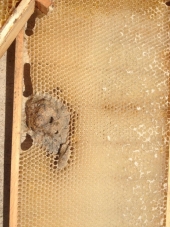




 4
4













Argue for your limitations and they are yours forever.




 5
5




ellen rosner wrote:Update:
So after one month, the bees was still coming over to the spot every time I came to the garden.
but,
yesterday when I got there there were TWO bees, (before had only been one- course I don't know if it was always the same one, but seems likely).
and they both kept buzzing around me,
and one stung me - altho no stinger in me, but a pinch on my arm and a red mark,
and they kept buzzing around me whenever I came near that spot.
seemed they want to drive me out!
I have never seen behavior like this, and altho I usually have LOTS of bees in my garden, I've never been stung, except once, when I grabbed something, not knowing I was grabbing the bee too.
I don't know what kind of bee it is, I try to see it but cannot see what kind.
any thoughts?
I am now a little concerned about going to my garden...
I know bees are in grave danger, but also - I don't want to get stung....
thanks

























ellen rosner wrote:some of the articles say that in winter they will die never to return.
others say in winter, all will die, except the queen, who will continue.
do you know which is correct?
 As for getting rid of them, they can still be safely relocated, so they don't have to die. Now is the best time to do that because there are not many hatched out yet. Later in the summer, it could turn into a very large hive. If you think you may be allergic or sensitive to the stings though, you should definitely get someone else to do it for you.
As for getting rid of them, they can still be safely relocated, so they don't have to die. Now is the best time to do that because there are not many hatched out yet. Later in the summer, it could turn into a very large hive. If you think you may be allergic or sensitive to the stings though, you should definitely get someone else to do it for you.




Mediterranean climate, hugel trenches, fabulous clay soil high in nutrients, self-watering containers with hugel layers, keyhole composting with low hugel raised beds, thick Back to Eden Wood chips mulch (distinguished from Bark chips), using as many native plants as possible....all drought tolerant.




Mediterranean climate, hugel trenches, fabulous clay soil high in nutrients, self-watering containers with hugel layers, keyhole composting with low hugel raised beds, thick Back to Eden Wood chips mulch (distinguished from Bark chips), using as many native plants as possible....all drought tolerant.




Deb Stephens wrote:
I'm curious about your reaction to the sting. What were your symptoms, etc.? (Just asking because I know there is a wide range of reactions -- including the very serious anaphylaxis.) I'm wondering why the doctor thinks your next sting is likely to be worse. I've not heard that before.








ellen rosner wrote:About 7-8 hours after sting, I had a bad case of the chills. It was 90 degrees outside, 78 in my apartment, and I had the heat on, and in winter clothes, wrapped in a blanket. It lasted several hours before I fell asleep and woke up next day, feeling ok, except shaky from not eating since lunch the day before.
Weird.
I didn't go to a doctor. No need.
My comment about the next sting based on, among some other comments, my friend who's been a beekeeper for 20+ years. That is her understanding.
True or not, I don't intend to find out.
 but you may feel better knowing that you probably aren't allergic to bee/wasps.
but you may feel better knowing that you probably aren't allergic to bee/wasps.




Philipp Mueller wrote:The wasps in my region tend to build a new nest every year. The queen survives the winter and starts a new nest in the spring. I have never seen wasps using their nest a second season. Of course, european wasps might be completely different to yours.




Cristo Balete wrote:One thing I just learned about the paper wasp nests, the ones that look like giant head-sized turbans on the eaves of a shed or house, Blue Jays, Scrub Jays, etc., tear these apart. I thought I was going to lose a whole summer of needing to do work on the pond, when a giant nest showed up on a tree nearby. I couldn't get to it, the opening was on the water side. About a week later the Jays had it torn to shreds! Don't know how they could do it in the daylight. They don't fly at night, that I know of, unless it's emergency hornet elimination flying! Great guys!!
 1
1




Argue for your limitations and they are yours forever.
 1
1





|
I'm full of tinier men! And a tiny ad:
Homestead Pigs Course
https://permies.com/wiki/365748/Homestead-Pigs
|


